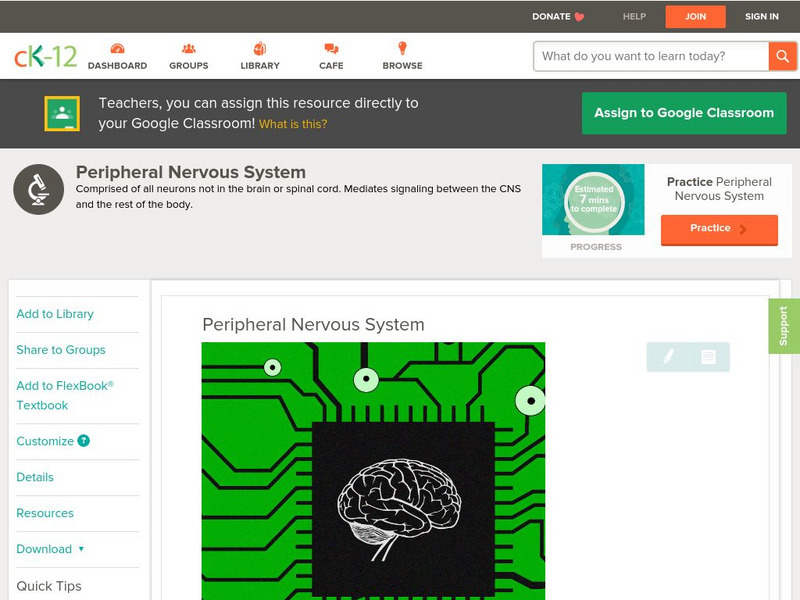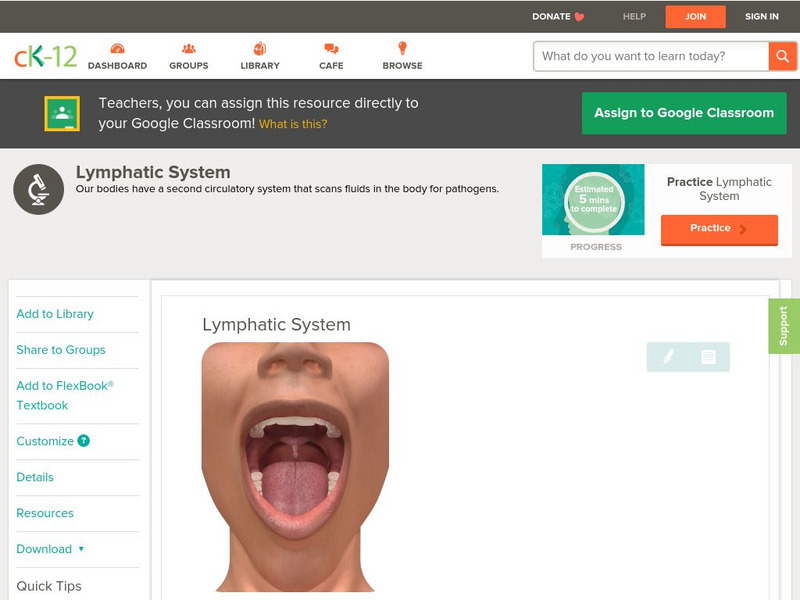CK-12 Foundation
Ck 12: Episd: Organization of the Human Body
[Free Registration/Login may be required to access all resource tools.] From basic cells to tissue to organ systems, identify and understand the structures and functions of the human body's organization.
Other
Get Body Smart: Human Anatomy and Physiology: Skeletal System
Students can learn about the human skeletal system through this easy-to-access tutorial. Sections include an introduction, organization of the skeleton, appendicular skeleton, and the axial skeleton. Interactive quizzes for each section...
Other
Get Body Smart: Respiratory System: Anatomy and Physiology
Students can learn about the human respiratory system's structures and functions through this easy-to-access tutorial. Sections include major zones and divisions, the nose and nasal cavity, the pharynx, the larynx, the trachea and...
eSchool Today
E School Today: Living Organisms Are Made Up of Cells
Discover how living things are made up of cells.
CK-12 Foundation
Ck 12: Organization of the Human Body
[Free Registration/Login may be required to access all resource tools.] A variety of learning opportunuties about levels of organization in the human body. Includes videos, activities, discussion questions, and quizzes.
OpenSciEd
Open Sci Ed: 7.3 Metabolic Reactions
This Metabolic Reactions unit has students investigating what happens to food after we eat, and how it affects the body.
CPALMS
Florida State University Cpalms: Florida Students: Levels of Organization
FSERL: Explanation of the hierarchical levels of living things.
CK-12 Foundation
Ck 12: Life Science: Organization of the Human Body
[Free Registration/Login may be required to access all resource tools.] Cells, like these nerve cells, do not work in isolation. To send orders from your brain to your legs, for example, signals pass through many nerve cells. These cells...
Other
Get Body Smart: Urinary System: Anatomy and Physiology
This innovative resource investigates the kidneys. Topics include the external and internal anatomy of the kidneys, histology of the cortex region, and histology of the medulla region.
Other
Get Body Smart: Human Nervous System: Anatomy and Physiology
The innovative tutorial investigates the human nervous system. Some topics explored are nerve cells, support cells, neurophysiology, brain, and spinal cord. Visual quizzes are also included.
OpenStax
Open Stax: Structural Organization of the Human Body
Try considering the structures of the body in terms of fundamental levels of organization that increase in complexity: subatomic particles, atoms, molecules, organelles, cells, tissues, organs, organ systems, organisms and biosphere....
CK-12 Foundation
Ck 12: Life Science: Respiratory System Organs
[Free Registration/Login may be required to access all resource tools.] When you think of the processes of breathing, the lungs probably come to mind. The lungs are the main organ of the respiratory system. However, many other organs are...
CK-12 Foundation
Ck 12: Life Science: Peripheral Nervous System
[Free Registration/Login may be required to access all resource tools.] The peripheral nervous system (PNS) contains all the nerves in the body that are found outside of the central nervous system. They include nerves of the hands, arms,...
CK-12 Foundation
Ck 12: Life Science: Lymphatic System
[Free Registration/Login may be required to access all resource tools.] If pathogens get through the body's first two lines of defense, a third line of defense takes over. This third line of defense involves the immune system. The immune...
CK-12 Foundation
Ck 12: Life Science: Digestive System Organs
[Free Registration/Login may be required to access all resource tools.] The mouth and stomach are just two of the organs of the digestive system. Other digestive system organs are the esophagus, small intestine, and large intestine....
The Wonder of Science
The Wonder of Science: Ms Ls1 3: Interacting Body Systems
Work samples, phenomena, assessment templates, and videos that directly address standard MS-LS1-3: interacting body systems.
BSCS Science Learning
Bscs Science Learning: Virtual Microscope: Human Tissue
Like a real microscope, the Virtual Microscope will allow you to examine slide samples more closely. You will be able to collect samples and save them for further observation.
OpenSciEd
Open Sci Ed: Net Logo: Villi Absorption
This simulation explores the relationship between the amount of surface area in the small intestine and the rate at which it absorbs food particles into the circulatory system.












